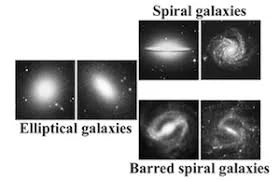Galaxy and their classification
From our school days we know that we live in the Earth, which is in the Solar System and the Solar System is a huge family part of the Milkyway Galaxy. But most of us do not know what the galaxy or the galaxy is? In addition, the galactic galaxy is not the only galaxy in the universe. On the contrary, there are also many large, small and bizarre neighboring galaxies with our galaxy galaxy.
 |
| Galaxy and their classification |
Definition of galaxy
The word galaxy is related to a huge family of gas, dust, arbor stars and their solar system, which is tied to gravity. The size of the galaxies ranges from a few hundred million stars to the Vaman galaxies to galaxies with large trillions of stars, in which each star revolves around the center of its galaxy. The number of stars in some galaxies is more than the number of sand particles on earth!
Classification of Galaxies
Based on the visual profile of the galaxy, astronomers classify them in different categories. Of these, the most famous classification of Hubble is 'Hubble's tuning fork'. According to this the galaxies are classified in the following categories.
Spiral galaxies
So far, 72 percent galaxies in the galaxy inspected by the galaxies are spiral galaxies. From these there is a giant spiral platter rotating of stars, nebulae, which is covered with dark matter around it. The giant spiral galaxy has three parts, the central bulge, the disk and the halo.
- Central bulge: This is a circular structure located in the center of the galaxy. It contains mostly ancient stars.
- Disk: The saucers are mainly washed, gas and new stars. This saucer has its own arms structure. Our Sun Mandakini Galaxy is located on a similar arm.
- Halo: The halo of the galaxy is a central bulge and circular structure around some part of the saucer. This halo contains the old star array of stars, which is called the globular star group.
If the left arm of the spiral galaxy is not clearly defined, then it is flocculent spiral galaxy, which is distinct from the grand design spiral galaxy, whose arm is clearly and well-defined.
Barred Spiral Galaxies
The disrupted spiral galaxy also has properties like normal spiral galaxies, but in the central bulge of this galaxy, there is a thick strip with a full-width wire, which is spread to the saucer. Its luminous central bulge consists of mostly ancient red stars and there is less activity in it. Its center rods and saucers have intense activity with the construction of stars. Most astronomers believe that our Milky Way galaxy is also a circular spiral galaxy.
Hubble showed the normal spiral to S. and used the SB for the rodic spiral. For the subclass of each class, the alphabet s, b and c were used for the alphabet. In the Sa and SBa, the nucleus is very large, it has a close passphrase in thick form, while the central bulge of the S and SBc galaxies is small and the arm is spread far and wide.
Elliptical galaxies:
Oval galaxies are like an egg, like any stretched sphere. Hubble was divided into subclasses called the ellipticity based on the amount of flap it was. Ellipticality in the context of two insurance This galaxy has 8 subclasses from E0 to E7. In this, E0 is almost circular, whereas E7 is the most oval. These galaxies are mostly ancient stars, and due to the absence of dust and gas, the construction of new stars is very rare.
The most massive galaxies in our universe are oval galaxies. Most of the galaxies are made up of mutual reactions of many galaxies, which include collision and merging. Large oval galaxies are commonly found around the center of the giant galaxy group. These galaxies have a subclass called Shell galaxies. Armor galaxy is essentially a elliptical galaxy that has a shield of stars around it which has more blueness than the original galaxy.
On average, the stars of oval galaxies are more ancient than stars of comparatively spiral galaxies. 10-15% of galaxies of galaxy galaxy Virgo Supercluster are oval, and their number is not even greater in the universe.
Lenticular galaxies:
In addition to spiral and elliptical galaxies, some galaxies whose size is similar to the saucer but do not contain greens. Hubble believed that they were in the middle of the spiral galaxy and elliptical galaxy, and they considered the S0 class. They are also called lenticular galaxies.
Irregular galaxies:
Unlike the spiral and elliptical galaxies, irregular galaxies do not have regular or symmetric shapes. We can divide these into two subclasses, Irr I and Irr II. Irr I square galaxy has a H II area, which is the area of hydrogen gas and in it there are new warm stars of the population of class I. Whereas Irr II galaxies have huge dense clouds of dust, which prevent the light of stars. These cloud clouds make it impossible to see stars of these galaxies differently.
Author's message
The study of galaxies makes us feel the vastness of the universe and our smallness. Each galaxy is unique and different in its own way, like the different continents on earth. Hubbal's Tuning Fark image is not the only solution for the classification of galaxies. There are also some other categories of classification of galaxies. But every day astronomers are searching for new galaxies and those galaxies do not fit into any of these categorizations. The classification of galaxies is still in development phase and the research is continuing.